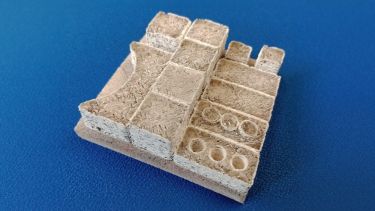Across the globe deserts are growing and expanding into more habitable landscapes. However, they could also prove to be a major resource of ‘zero carbon’ construction materials requiring only sunlight and sand as the raw inputs. Such materials could themselves also contribute to efforts to combat desert expansion.
This proof of concept project examined the viability of a technology that can use concentrated sunlight to sinter sand into quality assured building blocks at economic rates. Aside from replacing more high carbon manufacturing processes such as concrete blocks and brick making, the vision is for a fully scalable technology suitable for communities ranging from tens to thousands. By generating construction materials within deserts themselves, the potential to also directly utilise these in measures to limit/mitigate desert growth as part of barrier schemes and constructed microclimates becomes very attractive.
Initial proof of concept studies funded through the Royce Equipment Access scheme at the Sheffield University Royce Centre investigated the sintering process using 1/10th scaled down ‘sand’ particles to generate scale blocks using an Aconity Mini 3D printer.
It was demonstrated that a range of model blocks of different shapes and sizes could be generated, and that crucially these could provide practically useful compressive strengths of the order of 10N/mm2, a strength comparable to common building bricks.
Solid, lattice and hollow sand filled samples all performed well, indicating that strength levels that are of practical use can be achieved and that it is not necessary to produce 100% sintered material giving a corresponding reduction in required energy input and increase in speed of production.
Using this proof of concept project as a springboard, we will be seeking further funding to take this work to the next stage: to develop the technology for a viable printer unit using sunlight and to optimise the printing processes and internal block design for maximum strength and minimum energy input.
Prof. Colin Smith
Department of Civil and Structural Engineering, University of Sheffield
In principle, blocks can be generated in any required shape and internal configuration for a wide range of common construction applications including walls and arches. In addition to buildings, they could find use in applications such as anti-sand shields, contour trench lining, microclimate generation, water trapping, and insulation.
The production system itself could be modular - e.g., mobile 1m3 robotic units individually generating bricks, to larger scale fixed production units. The method could also be adapted for off-planet usage e.g., the moon, or in non-desert environments using lasers powered by excess renewable energy.
Scoping calculations, show that bricks could potentially be generated at a rate of ~4000/day from a 10m x 10m area of captured sunlight. Since the precision normally associated with conventional 3D printing is not required in the envisioned applications, design of a robust mechanically simple printer is believed to be tractable.
Equipment used:
Aconity Mini 3D printer via the Royce Equipment Access Scheme

